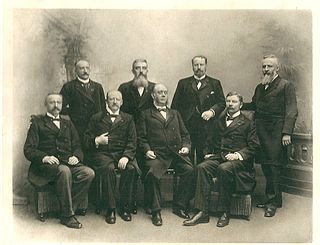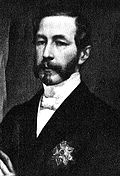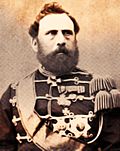Liberalism in the Netherlands started as an anti-monarchical effort spearheaded by the Dutch statesman Thorbecke, who almost single-handedly wrote the 1848 Constitution of the Netherlands that turned the country into a constitutional monarchy.

The First Van Agt cabinet, also called the Van Agt–Wiegel cabinet was the executive branch of the Dutch Government from 19 December 1977 until 11 September 1981. The cabinet was formed by the christian-democratic Christian Democratic Appeal (CDA) and the conservative-liberal People's Party for Freedom and Democracy (VVD) after the election of 1977. The cabinet was a centre-right coalition and had a slim majority in the House of Representatives with Christian Democratic Leader Dries van Agt serving as Prime Minister. Liberal Leader Hans Wiegel served as Deputy Prime Minister and Minister of the Interior.

The First Drees cabinet, also called the Second Drees cabinet was the executive branch of the Dutch Government from 15 March 1951 until 2 September 1952. The cabinet was a continuation of the previous Drees–Van Schaik cabinet and was formed by the christian-democratic Catholic People's Party (KVP) and Christian Historical Union (CHU), the social-democratic Labour Party (PvdA) and the conservative-liberal People's Party for Freedom and Democracy (VVD) after the fall of the previous cabinet. The cabinet was a centrist grand coalition and had a substantial majority in the House of Representatives with Labour Leader Willem Drees serving as Prime Minister. Prominent Catholic politician Frans Teulings the Minister of the Interior in the previous cabinet served as Deputy Prime Minister and Minister without portfolio for the Interior.

Johan Rudolph Thorbecke was a Dutch liberal statesman, one of the most important Dutch politicians of the 19th century. In 1848, he headed the commission that drafted the revision of the Constitution of the Netherlands, giving less power to the king and more to the States General, and guaranteeing more religious, personal and political freedom to the people.

Pieter Philip van Bosse was a Dutch liberal politician. Serving as minister of Finance in six cabinets throughout the middle of the 19th century, Van Bosse led many reforms that liberalised the Dutch economy. He led a cabinet himself as Prime Minister of the Netherlands from 4 June 1868 to 4 January 1871.

The Second Gerbrandy cabinet, also called the Third London cabinet was the Dutch government-in-exile from 27 July 1941 until 23 February 1945. The cabinet was formed by the political parties Roman Catholic State Party (RKSP), Social Democratic Workers' Party (SDAP), Anti-Revolutionary Party (ARP), Christian Historical Union (CHU), Free-thinking Democratic League (VDB) and the Liberal State Party (LSP) following the resignation of First Gerbrandy cabinet on 12 June 1941. The national unity government (War cabinet) was the third of four war cabinets of the government-in-exile in London during World War II.

The Fourth Colijn cabinet was the cabinet of the Netherlands from 24 June 1937 until 25 July 1939. The cabinet was formed by the political parties Roman Catholic State Party (RKSP), Anti-Revolutionary Party (ARP) and the Christian Historical Union (CHU) after the election of 1937. The right-wing cabinet was a majority government in the House of Representatives. It was the fourth of five cabinets of Hendrikus Colijn, the Leader of the Anti-Revolutionary Party as Prime Minister.

The Second Colijn cabinet was the cabinet of the Netherlands from 26 May 1933 until 31 July 1935. The cabinet was formed by the political parties Roman Catholic State Party (RKSP), Anti-Revolutionary Party (ARP), Christian Historical Union (CHU), Liberal State Party (LSP) and the Free-thinking Democratic League (VDB) after the election of 1933. The centre-right cabinet was a majority government in the House of Representatives. It was the second of five cabinets of Hendrikus Colijn, the Leader of the Anti-Revolutionary Party as Prime Minister.

The Third Ruijs de Beerenbrouck cabinet was the cabinet of the Netherlands from 10 August 1929 until 26 May 1933. The cabinet was formed by the political parties Roman Catholic State Party (RKSP), Anti-Revolutionary Party (ARP) and the Christian Historical Union (CHU) after the election of 1929. The centre-right cabinet was a majority government in the House of Representatives. It was the last of three cabinets of Charles Ruijs de Beerenbrouck, the Leader of the Roman Catholic State Party as Prime Minister.

The Cort van der Linden cabinet was the cabinet of the Netherlands from 29 August 1913 until 9 September 1918. The cabinet was formed by Independent Liberal Pieter Cort van der Linden after the election of 1913 and received confidence and supply in the House of Representatives from other Independent Liberals and several members of the Free-thinking Democratic League (VDB), Christian Historical Union (CHU) and the Liberal Union (LU) and from 15 December 1917 also the Economic League (EL). The centre cabinet was officially a minority government in the House of Representatives but was also supported by additional members of the Anti-Revolutionary Party (ARP) for a majority. It was the last cabinet with a Liberal Prime Minister until Mark Rutte became Prime Minister 92 years later on 14 October 2010.

The Kuyper cabinet was the cabinet of the Netherlands from 1 August 1901 until 17 August 1905. The cabinet was formed by the political party Anti-Revolutionary Party (ARP) and Independent Catholics (I) after the election of 1901. The right-wing cabinet was a minority government in the House of Representatives. Abraham Kuyper, the Leader of the Anti-Revolutionary Party was Prime Minister.

The Theo Heemskerk cabinet was the cabinet of the Netherlands from 12 February 1908 until 29 August 1913. The cabinet was formed by the political party Anti-Revolutionary Party (ARP) and the General League of Roman Catholic Caucuses (ABRK) following the fall of the De Meester cabinet 21 December 1907. The centre-right cabinet was a minority government in the House of Representatives but was supported by Independent Catholics and Independent Protestants for a majority. After the election of 1909 the Anti-Revolutionary Party and the General League of Roman Catholic Caucuses received a plurality of the votes and the cabinet could continued to govern as a majority government from 27 July 1909. Theo Heemskerk of the Anti-Revolutionary Party was Prime Minister.

The Pierson cabinet was the cabinet of the Netherlands from 27 July 1897 until 1 August 1901. The cabinet was formed by the political party Liberal Union (CU) after the election of 1897. The centre-right cabinet was a minority government in the House of Representatives but was supported by Independent Liberals for a majority. Nicolaas Pierson of the Liberal Union was Prime Minister.

The Jan Heemskerk cabinet was the cabinet of the Netherlands from 23 April 1883 until 21 April 1888. The cabinet was formed by Independent Conservatives, Independent Liberals and Independent Catholics after the election of 1883. The right-wing cabinet was a majority government in the House of Representatives. Independent Liberal Conservative Jan Heemskerk was Prime Minister.

The Van Lynden van Sandenburg cabinet was the cabinet of the Netherlands from 20 August 1879 until 23 April 1883. The cabinet was formed by Independent Conservatives, Independent Liberals, Independent Catholics and Independent Protestants after the election of 1879. The centre-right cabinet was a majority government in the House of Representatives. Independent Protestant Christian Democrat Theo van Lynden van Sandenburg was Prime Minister.

The Kappeyne van de Coppello cabinet was the cabinet of the Netherlands from 3 November 1877 until 20 August 1879. The cabinet was formed by Independent Liberals after the election of 1877. The centre-right cabinet was a minority government in the House of Representatives. Independent Classical Liberal Jan Kappeyne van de Coppello was Prime Minister.

The Heemskerk–Van Lynden van Sandenburg cabinet was the cabinet of the Netherlands from 27 August 1873 until 3 November 1877. The cabinet was formed by Independent Conservatives and Independent Liberals after the election of 1873. The right-wing cabinet was a majority government in the House of Representatives. Independent Liberal Conservative Jan Heemskerk was Prime Minister.

The De Vries–Fransen van de Putte cabinet was the cabinet of the Netherlands from 6 July 1872 until 27 August 1873. The cabinet was formed by Independent Liberals after the death of Prime Minister Johan Rudolph Thorbecke on 4 June 1872. The Centre-right cabinet was a majority government in the House of Representatives. Independent Liberal Conservative Gerrit de Vries was Prime Minister.

The Van Bosse–Fock cabinet was the cabinet of the Netherlands from 4 June 1868 until 4 January 1871. The cabinet was formed by Independent Liberals. The Centre-right cabinet was a minority government in the House of Representatives. Independent Liberal Pieter Philip van Bosse was Prime Minister.

The Van Zuylen van Nijevelt cabinet was the cabinet of the Netherlands from 1 June 1866 until 4 June 1868. The cabinet was formed by Independent Conservatives after the election of 1866. The right-wing cabinet was a minority government in the House of Representatives. Independent Liberal Conservative Jules van Zuylen van Nijevelt was Prime Minister.
















